A procession is an organized body of people walking in a formal or ceremonial manner.[1]

A procession is an organized body of people walking in a formal or ceremonial manner.[1]


Processions have in all peoples and at all times been a natural form of public celebration, as forming an orderly and impressive ceremony. Religious and triumphal processions are abundantly illustrated by ancient monuments, e.g. the religious processions of Egypt, those illustrated by the rock-carvings of Boghaz-Keui, the many representations of processions in Greek art, culminating in the great Panathenaic procession of the Parthenon Frieze, and Roman triumphal reliefs, such as those of the arch of Titus.[1]
Processions played a prominent part in the great festivals of Greece, where they were always religious in character. The games were either opened or accompanied by more or less elaborate processions and sacrifices, while processions from the earliest times formed part of the worship of the old nature gods, as those connected with the cult of Dionysus and the Phallic processions, and later formed an essential part of the celebration of the great religious festivals (e.g. the processions of the Thesmophoria, and that of the Great Dionysia), and of the mysteries (e.g. the great procession from Athens to Eleusis, in connection with the Eleusinia).[1]
The most prominent of the Roman processions was that of the Triumph, which had its origin in the return of a victorious army headed by their general, who accompanied by the army, captives, spoils, the chief magistrate, priests bearing the images of the gods, amidst strewing of flowers, burning of incense and the like (Ovid, Trist. iv. 2, 3 and 6), proceeded in great pomp from the Campus to the Capitol to offer sacrifice.
Connected with the triumph was the pompa circensis, or solemn procession that preceded the games in the circus. It first came into use at the Ludi Romani, when the games were preceded by a great procession from the Capitol to the Circus. The praetor or consul who appeared in the ponipa circensis wore the robes of a triumphing general (see Mommsen, Staatsrec/zt I. 397 for the connection of the triumph with the ludi). Thus, when it became customary for the consul to celebrate games at the opening of the consular year, he came, under the empire, to appear in triumphal robes in the processus consularis, or procession of the consul to the Capitol to sacrifice to Jupiter.[1]
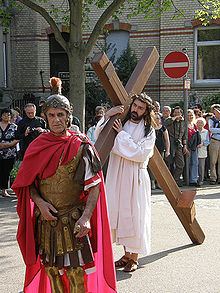
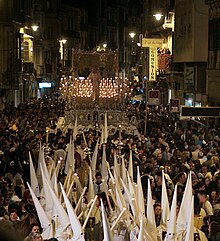
After the ascendency of Christianity in the Roman Empire, the consular processions in Constantinople retained their religious character, now proceeding to Hagia Sophia, where prayers and offerings were made; but in Rome, where Christianity was not so widely spread among the upper classes, at first the tendency was to convert the procession into a purely civil function, omitting the pagan rites and prayers, without substituting Christian ones.[2]
Only after Theodosius did the processions become a religious event, replete with icons, crosses, and banners. There were other local processions connected with the primitive worship of the country people, which remained unchanged, but they were eventually overshadowed by the popular piety of the Church. Such were those of the Ambarvalia, Robigalia, which were essentially rustic festivals, lustrations of the fields, consisting in a procession round the spot to be purified, leading the sacrificial victims with prayers, hymns, and ceremonies to protect the young crops from evil influence.[3]
Tertullian (2nd century) uses processio and procedere in the sense of to go out, appear in public, and, as applied to a church function, processio was first used in the same way as collecta, i.e. for the assembly of the people in a church.[4] In this sense it appears to be used by Pope Leo I,[5] while in the version by Dionysius Exiguus of the 17th canon of the Council of Laodicea (about 363–364) Ancient Greek: σονάξεσι, is translated by processionibus.[1][6]
For the processions that formed part of the ritual of the Eucharist, those of the introit, the gospel and the oblation, the earliest records date from the 6th century and even later,[7] but they evidently were established at a much earlier date. As to public processions, these seem to have come into rapid vogue after the recognition of Christianity as the religion of the empire. Those at Jerusalem would seem to have been long established when described by the author of the Peregrinatio Sylviae towards the end of the 4th century.[1]
Very early were the processions accompanied by hymns and prayers, known as litaniae, rogationes or supplicationes. It is to such a procession that reference appears to be made in a letter of St Basil,[8] which would thus be the first recorded mention of a public Christian procession. The first mention for the Western Church occurs in St Ambrose.[9] In both these cases the litanies are stated to have been long in use. There is also mention of a procession accompanied by hymns, organized at Constantinople by St John Chrysostom (c. 390–400) in opposition to a procession of Arians, in Sozomen.[10]
Some liturgists maintain that the early Church in its processions followed Old Testament precedents, quoting such cases as the procession of the ark round the walls of Jericho,[11] the procession of David with the ark,[12] the processions of thanksgiving on the return from captivity, &c. The liturgy of the early Church as Duchesne shows[13] was influenced by that of the Jewish synagogue, but the theory that the Church's processions were directly related to the Old Testament ritual is of later origin.[1]
In times of calamity litanies were held, in which the people walked in robes of penitence, fasting, barefooted, and, in later times, frequently dressed in black (litaniae nigrae). The cross was carried at the head of the procession and often the gospel and the relics of the saint were carried. Gregory of Tours gives numerous instances of such litanies in time of calamity; thus he describes[14] a procession of the clergy and people round the city, in which relics of St Remigius were carried and litanies chanted in order to avert the plague. So, too, Gregory the Great[15] writes to the Sicilian bishops to hold processions to prevent a threatened invasion of Sicily. A famous instance of these penitential litanies is the litania septiformis ordered by Gregory the Great in the year 590, when Rome had been inundated and pestilence had followed.[1] In this litany seven processions, of clergy, laymen, monks, nuns, matrons, the poor, and children respectively, starting from seven different churches, proceeded to hear mass at St. Maria Maggiore.[16] This litany has often been confused with the litania major, introduced at Rome in 598 (vide supra), but is quite distinct from it.
Funeral processions, accompanied with singing and the carrying of lighted tapers, were very early customary (see ceremonial use of lights), and akin to these, also very early, were the processions connected with the translation of the relics of martyrs from their original burying place to the church where they were to be enshrined.[17] From the time of the emperor Constantine I these processions were of great magnificence.[1]
Festivals involving processions were adopted by the Catholic Church from the pre-Christian Roman festive calendar. The litaniae majores et minores, which are stated by Hermann Usener[18] to have been first instituted by Pope Liberius (352-366). It is generally acknowledged that they are the equivalent of the Catholic Church of the Roman lustrations of the crops in spring, the Ambarvalia, &c. The litania major, or great procession on St Mark's day (April 25) is shown to coincide both in date and ritual with the Roman Robigalia, which took place ad. vii. Kal. Mai., and consisted in a procession leaving Rome by the Flaminian gate, and proceeding by way of the Milvian bridge to a sanctuary at the 5th milestone of the Via Claudia, where the flamen quirinalis sacrificed a dog and a sheep to avert blight (robigo) from the crops.[19] The litania major followed the same route as far as the Milvian bridge, when it turned off and returned to St Peter's, where mass was celebrated. This was already established as an annual festival by 598, as is shown by a document of Gregory the Great[20] that inculcates the duty of celebrating litaniam, quae major ab omnibus appellatur. The litaniae minores or rogations, held on the three days preceding Ascension Day, were first introduced into Gaul by Bishop Mamertus of Vienne (c. 470), and made binding for all Gaul by the First Council of Orléans (511). The litaniae minores were also adopted for these three days in Rome by Pope Leo III (c. 800).[1]
A description of the institution and character of the Ascensiontide rogations is given by Sidonius Apollinaris.[21] The solemnity of these, he says, was first established by Mamertus. Hitherto they had been erratic, lukewarm, and poorly attended (vagae, tepentes, infrequentesque). Those he instituted were characterized by fasting, prayers, psalms, and tears. In the Ambrosian rite the rogations take place after Ascension, and in the Spanish on the Thursday to Saturday after Whitsuntide, and in November (Synod of Girona, 517).[1]
The element of ritual was prominent in early modern Catholicism, even after Luther's critique of the "empty rituals" in late medieval Christianity. There were processions to commemorate almost all the holiday. Though 18th-century Church reformers made strides to simplify the liturgical year and its complex web of holidays, festivals and processions, these practices remained as essential to Catholic ritual traditions in 1750 as they had been in the 15th century.[22] After 1650 the number of processions was on the rise as processions became as essential to the observance of feast days as Catholic Mass. Some processions were tied to agricultural lifestyles, while others were pilgrimages to shrines and holy places, or to develop ties with other parishes.[23]
During the Reformation, the liturgical year was central to the liturgical practices of Catholicism. Beginning with the Christmas season (from Advent to Epiphany) and followed by the feasts of Easter, Passiontide and Pentecost , Trinity Sunday and the Feast of Corpus Christi.[24] In the early 18th century there were eleven processions of note at the village of Ettenkirch (near Lake Constance). These processions could travel to destinations as far as two hours away. Monthly processions took place around the Church, and on All Souls' Day and Palm Sunday.[23] Corpus Christi was one of the most elaborate.
Ascension Day was another important ceremony that held strong anti-Protestant meaning. In Herbolzheim the procession involved villagers "flying flags, crosses held high, singing and loudly recited prayers" as they passed near neighboring Protestant villages. When the Bishop of Strasbourg forbade the Ascension Day procession in 1743, believing the practice would create conflict with Protestants in neighboring towns, the Rhine Valley villagers protested.[25]
One of the effects of the Tridentine reform was to ensure that the variety of devotions that sprang up in ecclesiastically fragmented parts of Europe were connected with the rituals of the Catholic Church. Not all devotional practices were tolerated. The Josephine Reforms banned Good Friday processions with costumed figures and palmesel processions for Palm Sunday, but some still went on. On Palm Sunday villagers carried green branches re-enacting Christ's entry into Jerusalem, and Palmesel processions still took place with a representation of Christ on a donkey.[26] The parish of Niederwihl claimed possession of a piece of the True Cross and by the 18th century had introduced new processions for the Discovery of the True Cross (May 3) and the Elevation of the True Cross (September 14). The relic would be carried by the townspeople for processions through their agricultural fields integrating a Counter-Reformation devotional theme with the ancient fertility rites of the townsfolk's rural religion.[27]
The Story of the Stone, written in the 18th century, contains a description of the procession accompanying an Imperial Concubine:
Presently a faint sound of music was heard and the Imperial Concubine's procession at last came in sight. First came several pairs of eunuchs carrying embroidered banners. Then several more pairs with ceremonial pheasant-feather fans. Then eunuchs swinging gold-inlaid censers in which special 'palace incense' was burning. Next came a great gold-coloured 'seven phoenix' umbrella of state, hanging from its curve-topped shaft life a great drooping bell-flower. In its shadow was borne the Imperial Concubine's travelling wardrobe: her head-dress, robe, sash and shoes. Eunuch gentlemen-in-waiting followed carrying her rosary, her embroidered handkerchief, her spittoon, her fly-whisk, and various other items. Last of all, when this army of attendants had gone by, a great gold-topped palanquin with phoenixes embroidered on its yellow curtains slowly advanced on the shoulders of eight eunuch bearers.[28]

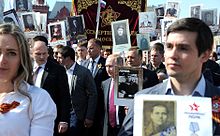
Many elements may be used to make a procession more significant than just "people walking in the same direction":
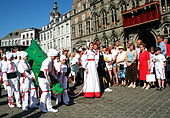
Edo-period documenters enjoyed drawing the processions of pleasure district beauties, such as Courtesan Parading With Attendants by Suzuki Harunobu. Similar parading courtesans feature in Cherry Blossom in the Evening on the Nakanomachi in Yoshiwara by Utagawa Hiroshige and True Scenery of the Gay Quarter of Minatozakimachi Shinminato by Utagawa Sadahide. The Lord Mayor's Show in London has long featured displays by the city's official trade guilds. Parades were at one time important advertisement when a traveling circus arrived in a new town. Today, many parades in the United States are sponsored by department stores, such as Macy's, which expect the public spectacle to lure shoppers to the store.
The Reception of the Ambassadors From Siam at the Château de Fontainebleau was one such example, documented by Jean-Léon Gérôme in 1864. The signing of surrender by Japanese diplomats and soldiers aboard an American battle ship at the end of World War II involved a strictly codified procession on and off the ship.

Processions play an important role in coronations, such as that of Elizabeth II of the United Kingdom in 1953, the Shah of Iran in 1967, Otumfuo Nana Osei Tutu II of the Ashanti in 1999, and Norodom Sihamoni of Cambodia in 2004.
Such as ancient Roman triumphs, the durbar processions of India, and modern reviewing of the troops by generals and heads of state. Return From Vienna, a painting by Jozef Brandt, shows war booty taken from the Turks being escorted into eastern Europe by soldiers.
Some processions are arranged for entertainment, purely for fun, such as those of community organizations and friendly societies, so popular in Great Britain and the United States of America.
Religious ceremonies have since prehistory employed the procession of holy objects to inspire solidarity of belief. The Doges of Venice once staged elaborate barge processions to bless the waters on which Venice's tightly controlled maritime economy depended.

Processions used to mark the beginning or end of an event, such as parades at the beginning of county fairs or at the Olympic Games, or processions that begin and end funerals, graduations, and weddings.
Processions are found in almost every form of religious worship, such as Holy Week processions. Some biblical examples were the processions with the Ark of Covenant and the procession of Jesus on a donkey into Jerusalem.[29]
In a narrower sense of going forth, proceeding, the term is used in the technical language of theology in the phrase Procession of the Holy Ghost, expressing the relation of the Third Person in the Triune Godhead to the Father and the Son.
It is impossible to describe in detail the vast development of processions during the Middle Ages. The most important and characteristic of these still have a place in the ritual of the Catholic Church, as well as those of the Church of England and the Orthodox Church.
The Procession Path (Lat. ambitus templi) is the route taken by processions on solemn days in large churches—up the north aisle, round behind the high altar, down the south aisle, and then up the centre of the nave.[30]
For the Catholic Church, the rules governing them are laid down in the Rituale Romanum (Tit. ix.), and they are classified in the following way:
There are also processions of honor, for instance to meet a royal personage, or the bishop on his first entry into his diocese (Pontif. Tom. iii.).
Those taking part in processions are to walk bare-headed (weather permitting), two and two, in decent costume, and with reverent mien; clergy and laity, men and women, are to walk separately. The cross is carried at the head of the procession, and banners embroidered with sacred pictures in places where this is customary; these banners must not be of military or triangular shape. Violet is the prescribed colour for processions, except on Corpus Christi, or on a day when some other colour is mandated. The officiating priest wears a cope, or at least a surplice with a violet stole, while other priests and clergy wear surplices.
A Eucharistic procession is one in which the Host is carried in procession in a monstrance. It is often covered with a canopy and accompanied with candles. At the litaniae majores and minores and other penitential processions, joyful hymns are not allowed, but the litanies are sung, and, if the length of the procession requires, the penitential and gradual psalms. As to the discipline regarding processions the bishop, according to the Council of Trent (Sess. 25 de reg. cap. 6), appoints and regulates processions and public prayers outside the churches.
The observance or variation of the discipline belongs to the Sacred Congregation of Rites; in pontifical processions, which are regulated by the masters of the ceremonies (magistri ceremoniarum pontificalium), these points are decided by the chief cardinal deacon. As to processions within the churches, some difference of opinion having arisen as to the regulating authority, the Sacred Congregation of Rites has decided that the bishop must ask, though not necessarily follow, the advice of the chapter in their regulation.[1]
Typically the procession commences with the phanarion (a lantern) followed by the cross,[note 1] flanked by processional banners and icons, then choir and clergy, the deacons with censers, the priests with icons, and then the faithful. Hymns particular to the event are sung. Typically the outside of the church is circled thrice; however, some processions proceed to a designated place where a ceremony, e.g., a baptism or burial, is performed.
|
Further information: Entrance (liturgical) |
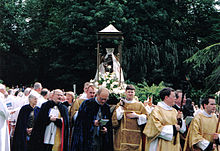
The Reformation abolished in all Protestant countries those processions associated with the doctrine of transubstantiation (Corpus Christi); the Sacrament of the Lord's Supper, according to the 28th Article of Religion of the Church of England was not by Christ's ordinance reserved, carried about, lifted up, or worshiped. It also abolished those associated with the cult of the Blessed Virgin and the saints. The stern simplicity of Calvinism, indeed, would not tolerate religious processions of any kind, and from the Reformed Churches they vanished altogether.[citation needed] The more conservative temper of the Anglican and Lutheran communions, however, suffered the retention of such processions as did not conflict with the reformed doctrines, though even in these Churches they met with opposition and tended after a while to fall into disuse.
Liturgical processions were revived in the Church of England by the members of the Oxford Movement during the 19th century.[32] In Ritual Notes, an Anglo-Catholic liturgical manual, it is stated that "A solemn procession as part of the ceremony proper to the occasion, is ordered to be held respectively at Candlemas; on Palm Sunday; at the Rogations (i.e. on April 25th and the three days preceding Ascension); and on Corpus Christi ..." "A procession is a distinct act of worship in itself, though it is desirable (and accords with ancient practice) that it should have a definite purpose, such as to commemorate some notable event, or to honour the Blessed Sacrament".[33]
The Lutheran practice has varied at different times and in different countries. Thus, according to the Württemberg Kirchenordnung of 1553, a funeral procession was prescribed, the bier being followed by the congregation singing hymns; the Brandenburg Kirchenordnung (1540) directed a cross-bearer to precede the procession and lighted candles to be carried, and this was prescribed also by the Waldeck Kirchenordnung of 1556. At present funeral processions survive in general only in the country districts; the processional cross or crucifix is still carried. In some provinces also the Lutheran Church has retained the ancient rogation processions in the week before Whitsuntide and, in some cases, in the month of May or on special occasions (e.g. days of humiliation, Busstage), processions about the fields to ask a blessing on the crops. On these occasions the ancient litanies are still used.

The wealth of display associated with processions makes them a rich subject for literary and visual art. Some examples include:
